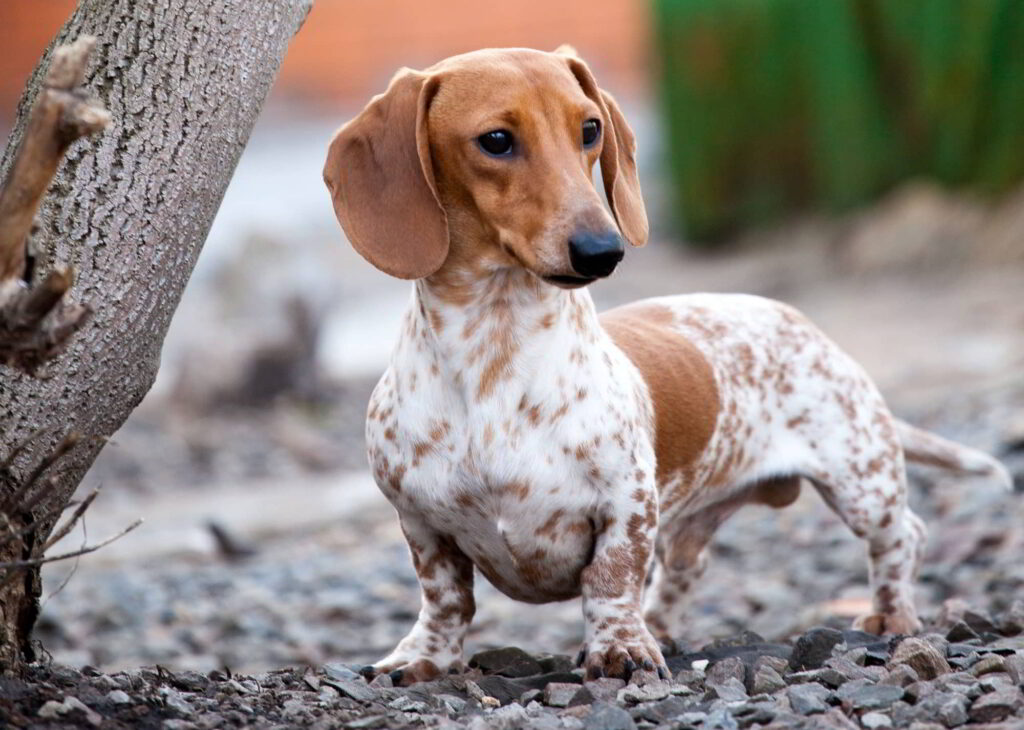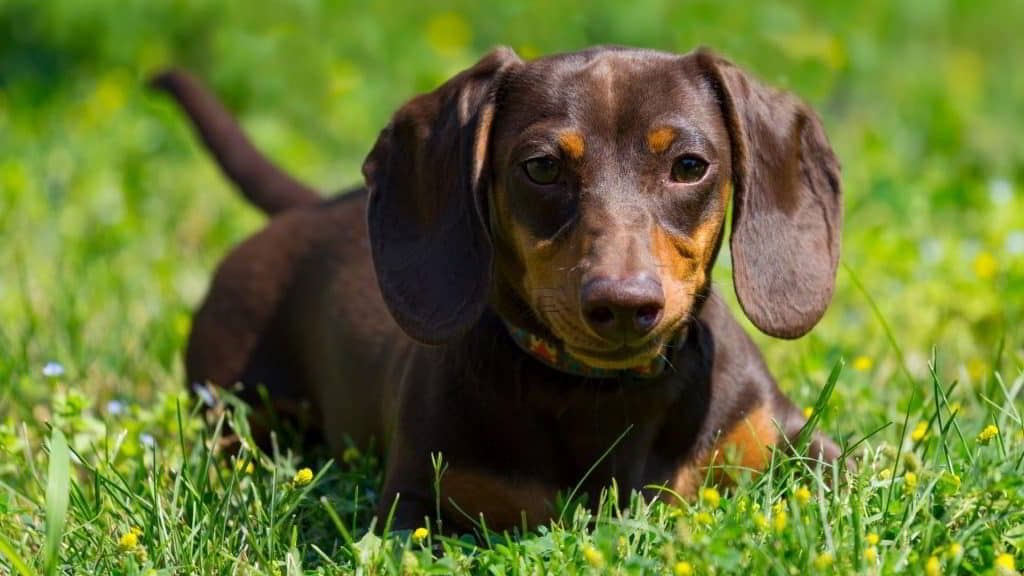Dachshund (Doxie): Dog Breed Profile
Characteristics, History, Care Tips, and Helpful Information for Pet Owners
The dachshund is an energetic, lovable dog breed with an endearing personality. Known affectionately as the doxie, wiener dog, hotdog, or sausage dog, this breed of short stature leaves a lasting impression. The dachshund is bred as standard or miniature size, but traits of this breed are similar for both. You might provide ramps or steps for getting up and down from chairs or beds. Despite its size, the dachshund tends to be quite protective and alert, so the breed can also make an excellent watchcanine.

| Breed Overview GROUP: Hound HEIGHT: 8 To 9 Inches (Standard); 5 To 6 Inches (Miniature) WEIGHT: 16 To 32 Pounds (Standard); Up To 11 Pounds (Miniature) COAT AND COLOR: Coat Varieties Include Smooth (Shorthaired), Longhaired, And Wire-Haired. Colors Include (But Not Limited To) Black, Tan, Fawn, Beige, Blue, Chocolate, And Red With Various Markings Such As Dapple, Piebald, Brindle, And Sable. LIFE EXPECTANCY: 12 To 16 Years |
Characteristics of the Dachshund
| Affection Level | High |
| Friendliness | Medium |
| Kid-Friendly | Low |
| Pet-Friendly | Low |
| Exercise Needs | Medium |
| Playfulness | High |
| Energy Level | Medium |
| Trainability | Medium |
| Intelligence | Medium |
| Tendency To Bark | High |
| Amount Of Shedding | Medium |
History of the Dachshund
The dachshund originated in Germany as a hunting dog. Though its origins can be traced as far back as the 15th century, the breed’s development really end up beinggan in 17th century Germany. Called dachshunds, which translates as “badger dogs,” these short hounds did just that-they hunted badgers. Their short legs, loose skin, big chests, determination, and independence were ideal for digging, entering tunnels, and of course, fighting badgers. Their flap-down ears help keep dirt and debris out when burrowing.
Further development of the breed created two sizes. Historically, the standard size continued to hunt badgers as well as wild boar, while the miniatures pursued hare and foxes. There’s also a middle size in Germany.
Dachshunds were brought to the U.S. as early as 1885, when the breed was recognized by the American Kennel Club (AKC), but increased in popularity in the 1930s and 1940s. To prevent them from being ostracized during World War II, they were temporarily called badger dogs in the U.S. They remain extremely popular dogs to this day.
Dachshund races, known as “wiener races,” are popular in some places for amusement. However, these are opposed by the Dachshund Club of America out of concerns over whether racing might injure the dogs.
Dachshund Care
Grooming needs of the dachshund depend upon their hair coat. The longhaired variety requires daily brushing but does not typically need professional grooming. Smooth dachshunds have a higher shedding rate than other varieties. All dachshunds should receive baths as needed (frequently if skin problems exist).
Be sure to do regular nail trims in order to prevent problems with the paws. Those flap-down ears also need attention to keep clean and monitor for signs of infection or mites. Maintain good oral hygiene by brushing your dog’s teeth a couple of times a week.
While loved for its bold personality, the dachshund may have a tendency to be stubborn, protective, and defensive. Many dachshunds are also known for their tendency to bark. Proper obedience training can turn these potential problems into beneficial qualities. They are tenacious, which was good in a hunting dog, but they might annoy you with this trait at home.
The propensity to dig may result in damage to your potted plants and yard. To avoid weight gain, your dachshund should get regular exercise. Daily walks are recommended, with a couple of 10-minute walks per day at the minimum, plus some play time, such as playing fetch. But proper nutrition is also key and you should be sure to avoid overfeeding.
You’ll need to take care to protect your dachshund’s back. As many as 25 percent of dachshunds have intervertebral disc disease, which can result in their spinal discs deteriorating and being susceptible to bulging when they have back strain or injury. Support the dog’s back when handling him. Jumping up and down from furniture should also be discouraged.
The dachshund can be a loving companion, lapdog, and even a family dog.

Dachshunds can be difficult to housebreak. You will need to be persistent and you may wish to use crate training. Be prepared with puppy pads and cleaning supplies.
Dachshunds are naturally prone to develop obesity. Keep that in mind and provide alternative activities for your pet.
The dachshund may not be the ideal breed to have around small children unless you take measures to train and socialize the dog extensively. In general, this breed will do better if raised with kids rather than introducing kids later in life. You will especially need to coach your children to handle this dog safely as his long back can be injured when handled inappropriately.
Dachshunds have a high prey drive, so they may not be a good match for a household that includes pet rodents. They usually get along well with other dachshunds but tend to want to be the top dog in a multi-pet household.
Common Health Problems
Responsible breeders strive to maintain the highest breed standards as established by kennel clubs like the AKC. Dogs bred by these standards are less likely to inherit health conditions. However, some hereditary health problems can occur in the breed. The following are some conditions to be aware of:
- Intervertebral disc disease
- Diabetes mellitus
- Epilepsy
- Gastric dilatation-volvulus
- Acanthosis nigricans
Diet and Nutrition
The amount of food needed will depend on the size of your dog, activity level, age, and other factors. Be sure to provide high-quality food and monitor your dog’s intake and weight. Take action early if you notice your dog is getting overweight and talk to your veterinarian about the appropriate feeding schedule, type of food, and amount to keep your dog at a healthy weight. This will help your dog achieve its natural lifespan.
Pros
- Good guard dogs
- Comical and engaging
- Snuggly and affectionate
Cons
- Loud barking
- Tough to housebreak
- Can be difficult with kids or other pets

Where to Adopt or Buy a Dachshund
If you think you’d like to adopt a dachshund, start by contacting a reputable organization such as for example:
- Dachshund Club of America
- All American Dachshund Rescue
- Dachshund Rescue of North America
These groups will be able to provide guidance and next steps for adoption. If you aren’t certain the breed is right for you, you may be able to try foster care to test if a dachshund is a good fit for your home on a trial basis.
More Dog Breeds and Further Research
As with any breed, if you think the dachshund is right for you, be sure to do plenty of research before obtaining one. Talk to other dachshund owners, reputable breeders and dachshund rescue groups to find out more.
If you are interested in comparing similar breeds, check these for benefits and drawbacks:
- Beagle Breed Profile
- Miniature Schnauzer Breed Profile
There are many different dog breeds out there. With a little research, you can find the right one to bring home.
Nhận xét
Đăng nhận xét